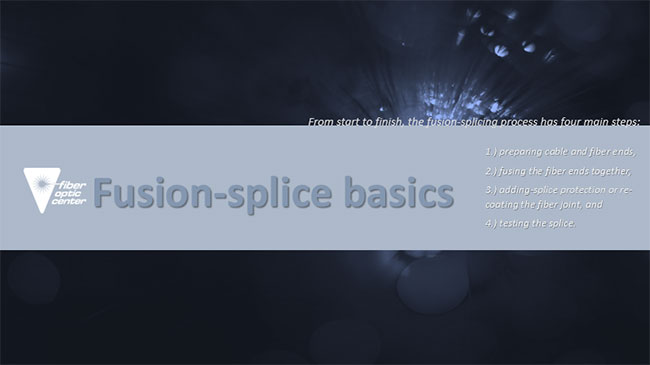In September 2019, FOC posted an article explaining the difference between mechanical and fusion splices. Fiber Optic Cable Splicing Explained. Fusion splicing is joining two fibers together by melting the two fibers together. Result is a near-seamless / lossless joint. The article below offers more detail on fusion-splicing procedures, especially the fiber “prep.”
The foundation of a good splice is good fiber preparation
Fusion splicing is used for joining cables during network installation projects, repairing cables, mounting pre-polished splice-on connectors, and many applications in factories that make fiber optic components and subsystems. For both field and factory splicing, the process requires the following supplies and equipment:
- aramid scissors and other tools for entering the cable and separating out individual fibers for splicing;
- stripping tools with hole sizes for removing fiber buffer coatings;
- alcohol and wipes to clean the bare fiber prior splicing;
- cleavers for terminating the fiber to the right length with high-quality end-faces;
- a fusion splicing machine;
- protective tubes or sleeves, or a fiber re-coating system;
- test instruments, such as loss test sets or OTDRs.
Some of the tools and equipment designed for field splicing differ from versions designed for factory or bench-top splicing. In the case of fusion splicing machines, for example, there are portable, lightweight units for field splicing, and some are supplied in kits that include a battery, other tools, and rugged cases.
From start to finish, the fusion-splicing process has four main steps: 1.) preparing the cable and fiber ends, 2.) fusing the fiber ends together, 3.) adding-splice protection or re-coating the fiber joint, and 4.) testing the splice.
Step (1.) is this article’s main focus, and we’ll offer tips on cleaving and cleaning. As for step (2.), the fusion splicing machine creates the fused joint. The operator is responsible for loading the fiber ends correctly, checking the settings, including the fiber-type program, and then hitting a button to start the fusion process. We’ll also comment on step (3.), protection, because it is critical in a splice’s long-term performance. Step (4.), testing, mainly is done with OTDRs or loss test sets, and details on testing will be covered in other articles.

Tips on fusion splicing from FOC’s technical experts
The goal of all fusion splicing – in the field or factory – is a low-loss joint that meets tensile-strength requirements. The strength tests are important to assure longevity. Experience has shown that many splice failures are due to breaks that often occur not right at the splice joint but nearby. The key steps for avoiding such breaks are good cleaning, cleaving, and splice protection.
1.) Fiber cleaning is a top priority. Dirt, dust, and other contaminants on the fiber can interfere with the fusion process, resulting in poor splice loss and strength problems. The fiber also must be entirely clean in the area to be re-coated or covered with a protective sleeve.
2.) Remember to keep tools and fixtures clean. Even in a more controlled environment, such as a tent, van, trailer, or factory, dust is unavoidable. The process of stripping fibers, for example, can create microscopic particles. This means it’s necessary to clean the cleaver, splicer, and other tools so they don’t contaminate the fiber and so the precision V-grooves and surfaces are not compromised.
3.) Keep multiple stripping tools on hand. Mechanical strippers can wear out, sometimes after a few hundred uses. Keep the tool clean and get another one when necessary. Be sure all the acrylate buffer coating is removed, without nicking the fiber.
4.) Use the right solvent. Many cable designs incorporate water-blocking gels, and all must be completely removed from the bare fiber before splicing and covering the joint. Many companies consider Isopropyl alcohol (IPA) suitable for fiber cleaning before splicing. If IPA is used, a high concentration – very low water percentage – is best. Some companies offer solvents specifically for cleaning cable gels.
5.) Don’t used compressed air for cleaning. Compressed air can create moisture, which can attract dust and interfere with a good splice. The best approach is use of optical-grade lint-free wipes with a solvent. FOC offers several options in dry or pre-saturated wipes packaged specifically for fiber optic applications.
6.) For field repairs, hope for good conditions? Sorry, there’s no easy-to-follow advice here. Field splicing must happen in less-than-ideal conditions. Possibly a lot less — bad weather, manholes, sewers, aerial installations, etc. Many field crews have trucks, tents, and other setups, and network operators try to install cable with coils of slack in the system to allow for repairs in such trucks. The goal is to try to work in as stable and as protected an environment as possible.
7.) Scribing or cleaving is critical. Scribing tools have a sharp edge for scoring the fiber before the technician manually breaks it. A cleaving tool similarly scores the fiber surface but then applies mechanically controlled pressure to break the fiber. The differences between scribers and cleavers is in price, technician skill, replacement part costs, and consistency in the scribing and breaking.
8.) The goal for fiber splice preparation is to cleave each fiber at 90° end face, with minimal lip, cracks, and hackle . The key to repeatable, robust splices is: clean and flat cleave. Any lips, hackles, etc. will only lower the quality of the splice (though most modern splice equipment can accommodate for less-than-ideal fiber cleaves, to an extent). Minor lips and hackle may be “fused away” or resolved by the fusion process. Large lips, however, can prevent the fiber ends from being positioned close together enough for a good fusion splice.
- “Lips” are protrusions that may occur on a fiber’s end face after being scribed and broken.
- “Hackle” refers to surface imperfections, also called “mist,” that can contribute to splice loss after fusing.
Clean fiber, clean cleave! Do that, and you’re 90% on the way to a robust cleave.
Fiber handline and cleaning is same for field splicing as for lab connectorization — the same philosophies apply. Don’t damage the fiber during stripping, make sure bare / stripped fiber does not contact any surface that may damage it, etc.
9.) The fusion process – the machine does the work. A fusion-splicing machine precisely positions the fiber ends and heats them so they fuse. The positioning relies on miniature digital cameras. The heat source usually is an electric arc from carefully controlled electrodes, although some splicers incorporate lasers or filaments. Many splicers also have a subsystem for performing a tensile-strength test and software to estimate splice loss using the internal cameras. Many also have a fixture and heat source for the protection sleeves, plus a tray or fixture to hold the protected splice while it cools.
10.) Select the correct splice-protection tube. Splice protection tubes or sleeves are made with a heat-shrinkable polymer and micro-rod strength members to prevent bending. Some sleeves have special coatings or adhesive (a hot-melt glue) on the inner wall, and there are options for strength-member material, color, and other characteristics. The preferred outside diameter and length depend on the application – whether the splice will be contained in an outside-plant closure, a splitter-device tray, a compact component or some other subsystem, etc. Note that tube specifications include the outside diameter after heat shrinking. It is critical that heat-shrinking protection tubes are fully shrunk, eliminating any chances of leaving air bubbles or the like trapped within.
11.) Estimated Splice Loss is just that—an estimate. Most common fusions splicers have a feature that calculated the estimated splice loss of a completed splice. This loss is calculated by comparing how well-aligned the joined fiber cores are. While this estimated loss CAN be accurate, it is not a true verification of the performance of your splice. Generally, such “Estimated Splice Losses” are used a kind of “rough filter”, to help ensure will meet performance tolerances, and you are identifying major-problem splices. But the best way to know the true performance of your splice is to do a separate power-meter / detector insertion loss test.
12.) Additionally about Splice Protection: Recoating is an alternative to tubes but mainly for factory splices. The recoating procedure uses a UV-cured acrylate like the buffer coating originally applied to the fiber during the draw process. The recoating systems have a fixture or mold to contain the coating material and cure it. This can take longer than a heat-shrink process, but it results in the same 250-µm outside diameter as the original fiber. This approach relies on benchtop equipment and usually is done in factories making pigtailed components and other devices.
Fusion-splicing machine options
As noted previously, there are multiple field and factory splicers on the market having different features (and price ranges). Options or so-called “bells and whistles” include the following: built-in cleaver, system for estimating splice loss, integrated tensile-strength test, oven for heat-shrink tubes, programs for different fiber sizes and types, ability to splice polarization-maintaining fiber, and “mass-fusion” features for splicing up to 12 fibers at one time. Field units are designed for portability and battery-powered operation but still incorporate many of the advanced features for testing and working with different fiber types.
A final comment is that fusion splicing technology has evolved over decades. The digital alignment and control features in the latest generations give excellent results, but vendors continue working on new features and enhancements. Another benefit of this long history is that there is lots of information on fusion splicing: training courses, instructional videos, white papers, technical articles, standards, and manufacturer support. FOC is glad to answer questions and provide further references on this topic.




